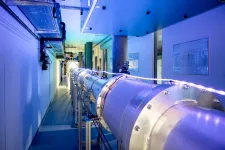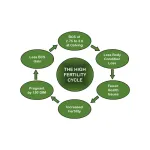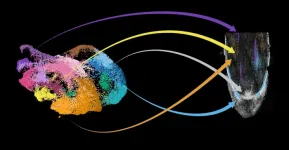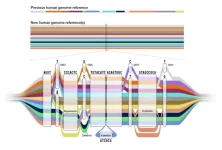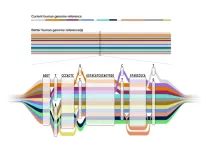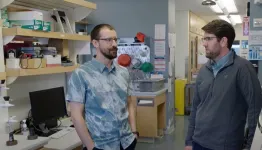(Press-News.org) A group of researchers led by Andreas Wallraff, Professor of Solid State Physics at ETH Zurich, has performed a loophole-free Bell test to disprove the concept of “local causality” formulated by Albert Einstein in response to quantum mechanics. By showing that quantum mechanical objects that are far apart can be much more strongly correlated with each other than is possible in conventional systems, the researchers have provided further confirmation for quantum mechanics. What’s special about this experiment is that the researchers were able for the first time to perform it using superconducting circuits, which are considered to be promising candidates for building powerful quantum computers.
An old dispute
A Bell test is based on an experimental setup that was initially devised as a thought experiment by British physicist John Bell in the 1960s. Bell wanted to settle a question that the greats of physics had already argued about in the 1930s: Are the predictions of quantum mechanics, which run completely counter to everyday intuition, correct, or do the conventional concepts of causality also apply in the atomic microcosm, as Albert Einstein believed?
To answer this question, Bell proposed to perform a random measurement on two entangled particles at the same time and check it against Bell’s inequality. If Einstein’s concept of local causality is true, these experiments will always satisfy Bell’s inequality. By contrast, quantum mechanics predicts that they will violate it.
The last doubts dispelled
In the early 1970s, John Francis Clauser, who was awarded the Nobel Prize in Physics last year, and Stuart Freedman carried out a first practical Bell test. In their experiments, the two researchers were able to prove that Bell’s inequality is indeed violated. But they had to make certain assumptions in their experiments to be able to conduct them in the first place. So, theoretically, it might still have been the case that Einstein was correct to be sceptical of quantum mechanics.
Over time, however, more and more of these loopholes could be closed. Finally, in 2015, various groups succeeded in conducting the first truly loophole-free Bell tests, thus finally settling the old dispute.
Promising applications
Wallraff’s group can now confirm these results with a novel experiment. The work by the ETH researchers published in the renowned scientific journal Nature shows that research on this topic is not concluded, despite the initial confirmation seven years ago. There are several reasons for this. For one thing, the ETH researchers’ experiment confirms that superconducting circuits operate according to the laws of quantum mechanics too, even though they are much bigger than microscopic quantum objects such as photons or ions. The several hundred micrometre-sized electronic circuits made of superconducting materials and operated at microwave frequencies are referred to as macroscopic quantum objects.
For another thing, Bell tests also have a practical significance. “Modified Bell tests can be used in cryptography, for example, to demonstrate that information is actually transmitted in encrypted form,” explains Simon Storz, a doctoral student in Wallraff’s group. “With our approach, we can prove much more efficiently than is possible in other experimental setups that Bell’s inequality is violated. That makes it particularly interesting for practical applications.”
The search for a compromise
However, the researchers need a sophisticated test facility for this. Because for the Bell test to be truly loophole-free, they must ensure that no information can be exchanged between the two entangled circuits before the quantum measurements are complete. Since the fastest that information can be transmitted is at the speed of light, the measurement must take less time than it takes a light particle to travel from one circuit to another.
So, when setting up the experiment, it’s important to strike a balance: the greater the distance between the two superconducting circuits, the more time is available for the measurement – and the more complex the experimental setup becomes. This is because the entire experiment must be conducted in a vacuum near absolute zero.
The ETH researchers have determined the shortest distance over which to perform a successful loophole-free Bell test to be around 33 metres, as it takes a light particle about 110 nanoseconds to travel this distance in a vacuum. That’s a few nanoseconds more than it took the researchers to perform the experiment.
Thirty-metre vacuum
Wallraff’s team has built an impressive facility in the underground passageways of the ETH campus. At each of its two ends is a cryostat containing a superconducting circuit. These two cooling apparatuses are connected by a 30-metre-long tube whose interior is cooled to a temperature just above absolute zero (–273.15°C).
Before the start of each measurement, a microwave photon is transmitted from one of the two superconducting circuits to the other so that the two circuits become entangled. Random number generators then decide which measurements are made on the two circuits as part of the Bell test. Next, the measurement results on both sides are compared.
Large-scale entanglement
After evaluating more than one million measurements, the researchers have shown with very high statistical certainty that Bell’s inequality is violated in this experimental setup. In other words, they have confirmed that quantum mechanics also allows for non-local correlations in macroscopic electrical circuits and consequently that superconducting circuits can be entangled over a large distance. This opens up interesting possible applications in the field of distributed quantum computing and quantum cryptography.
Building the facility and carrying out the test was a challenge, Wallraff says. “We were able to finance the project over a period of six years with funding from an ERC Advanced Grant.” Just cooling the entire experimental setup to a temperature close to absolute zero takes considerable effort. “There are 1.3 tonnes of copper and 14,000 screws in our machine, as well as a great deal of physics knowledge and engineering know-how,” Wallraff says. He believes that it would in principle be possible to build facilities that overcome even greater distances in the same way. This technology could, for instance, be used to connect superconducting quantum computers over great distances.
END
Entangled quantum circuits
2023-05-10
ELSE PRESS RELEASES FROM THIS DATE:
Simple management steps for a high fertility cycle in your dairy herd
2023-05-10
Philadelphia, May 10, 2023 – The dairy industry has seen a revolution over the past two decades in fertility success within herds. Widely adopted fertility programs are at the heart of this leap forward, along with the industry’s increased understanding—and optimization—of the holistic interactions among the body condition, overall health, and fertility of a dairy cow. In a recent mini-review appearing in a special fertility issue of JDS Communications®, published by Elsevier, researchers from the University of ...
Scientists release a new human “pangenome” reference
2023-05-10
Researchers have released a new high-quality collection of reference human genome sequences that captures substantially more diversity from different human populations than what was previously available. The work was led by the international Human Pangenome Reference Consortium, a group funded by the National Human Genome Research Institute (NHGRI), part of the National Institutes of Health.
The new “pangenome” reference includes genome sequences of 47 people, with the researchers pursuing the goal of increasing that number to 350 by mid-2024. With each person carrying a paired set of chromosomes, the current reference actually includes 94 distinct genome ...
Crops evolved by swapping genetic modules between cells
2023-05-10
Comparing individual cells across corn, sorghum, and millet reveals evolutionary differences among these important cereal crops, according to a new study led by New York University researchers.
The findings, published in Nature, bring researchers closer to pinpointing which genes control important agricultural traits such as drought tolerance, which will help scientists faced with a changing climate adapt crops to drier environments.
Corn, sorghum, and millet provide food for humans and animals around the world. Corn and sorghum are ancient relatives that evolved into two different species roughly 12 million years ago, and millet is a more distant relative.
Despite ...
Behind the scenes of a major genomic discovery
2023-05-10
EMBARGOED UNTIL WEDNESDAY, MAY 10, 2023, AT 11AM ET
New York, NY (May 10, 2023)—Eimear Kenny, PhD, had just completed undergrad and was working in her first computational genomics job more than 20 years ago when scientists announced the first (nearly) complete sequencing of the human genome—what was considered at the time to be the fundamental blueprint for all humans. The Human Genome Project aimed to map the entire genome in an effort to accelerate the diagnosis and eventual treatment of common and rare diseases.
Now, Dr. Kenny, ...
Human pangenome reference will enable more complete and equitable understanding of genomic diversity
2023-05-10
UC Santa Cruz scientists, along with a consortium of researchers, have released a draft of the first human pangenome—a new, usable reference for genomics that combines the genetic material of 47 individuals from different ancestral backgrounds to allow for a deeper, more accurate understanding of worldwide genomic diversity.
By adding 119 million bases—the “letters” in DNA sequences—to the existing genomics reference, the pangenome provides a representation of human genetic diversity that was not possible with a single reference genome. It is highly accurate, more complete and dramatically increases ...
New ‘pangenome’ offers more inclusive view of human genome
2023-05-10
New Haven, Conn. — When it was launched in April 2003, the Human Genome Project helped revolutionize biomedical research by providing scientists a reference map that allowed them to analyze DNA sequences for genetic clues to the origins of a host of diseases.
Twenty years later, a team of researchers that includes Yale scientists has created a new “pangenome” that fills in missing sequencing gaps from the original genome project and greatly expands the diversity of genomes represented.
The achievement is described in ...
Study: palliative care provided at point of oncology surgery does not improve patient outcomes
2023-05-10
One of the most important advances in palliative care in oncology over the past 15 years has been the recognition that palliative care specialists can improve cancer patients’ outcomes well before their end of life.
Palliative care is specialized care provided to individuals with a serious illness that focuses on decision-making support, pain and symptom management, as well as psychosocial interventions to improve quality of life.
Several past randomized clinical trials have shown palliative care specialists can improve the quality of life and lengthen the ...
Investigating social media to evaluate emergency medicine physicians’ emotional well-being during COVID-19
2023-05-10
About The Study: In this study, key thematic shifts and increases in language related to anxiety, anger, depression, and loneliness were identified in the content posted on social media by academic emergency medicine physicians and resident physicians during the pandemic. Social media may provide a real-time and evolving landscape to evaluate thematic content and linguistics related to emotions and sentiment for health care workers.
Authors: Anish K. Agarwal, M.D., M.P.H., M.S., of the ...
Analysis of BMI in early and middle adulthood and estimated risk of gastrointestinal cancer
2023-05-10
About The Study: In this secondary analysis of the Prostate, Lung, Colorectal, and Ovarian Cancer Screening Trial, overweight and obese body mass index (BMI) in early and middle adulthood was associated with an elevated risk of colorectal cancer and non-colorectal gastrointestinal cancers. The results of the current study prompt further exploration into the mechanistic role of obese BMI in carcinogenesis.
Authors: Holli A. Loomans-Kropp, Ph.D., M.P.H., of Ohio State University in Columbus, is the corresponding author.
To access the embargoed study: Visit our For The Media website at this link https://media.jamanetwork.com/
(doi:10.1001/jamanetworkopen.2023.10002)
Editor’s ...
UW Medicine scientists among leads of NIH pangenome studies
2023-05-10
UW Medicine genome experts made significant scientific contributions to a National Institutes of Health Human Genome Research Institute reference collection that better represents the genetic diversity of the world’s populations.
Called the Human Pangenome Reference Consortium, the multi-institutional effort expands and updates earlier work that started as the Human Genome Project. That original project, with drafts reported in 2001 and 2003, was based on a more limited sampling of human DNA. The goal then was to create an entire sequence of a human genome to use as a reference. ...
